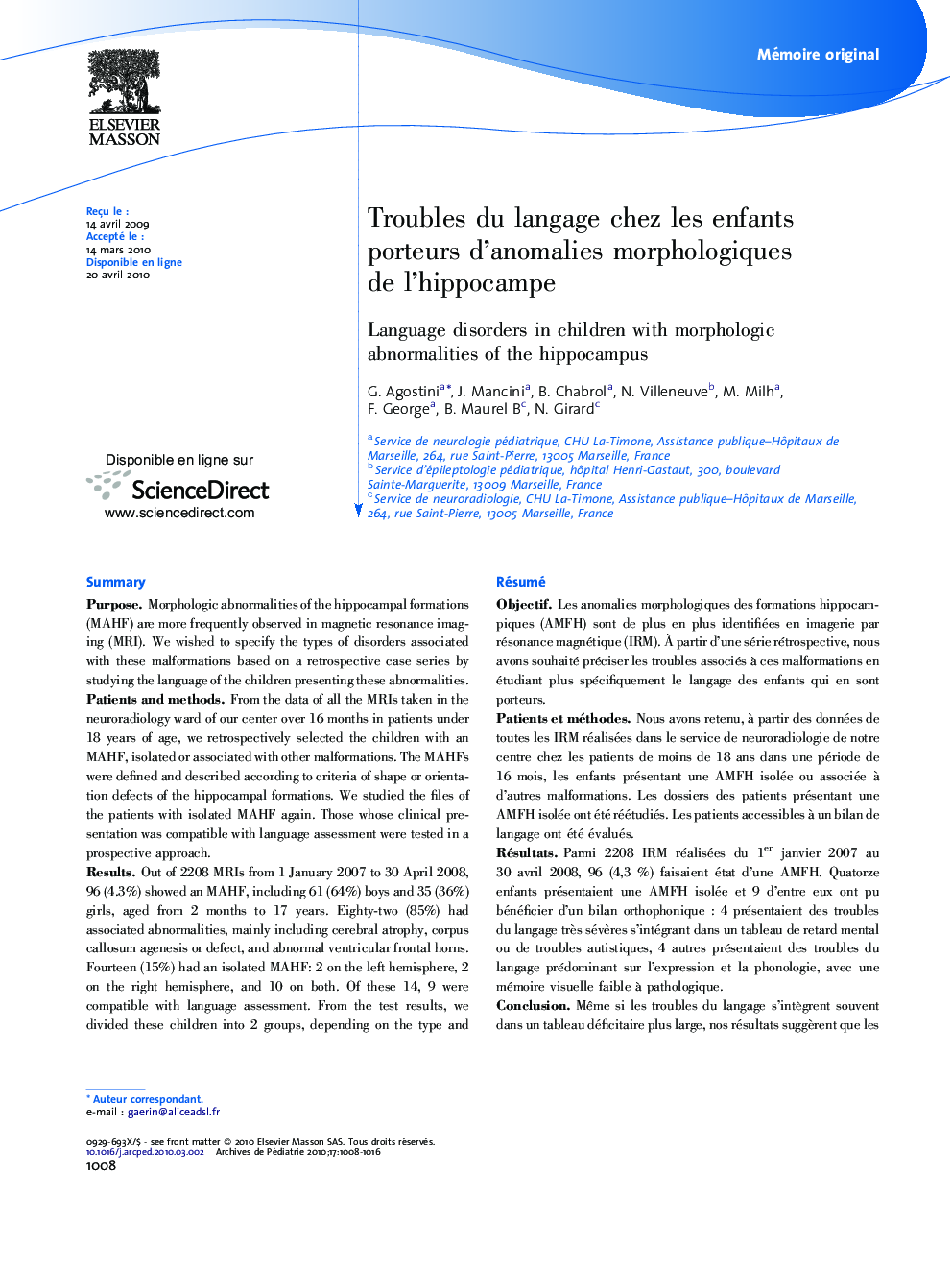| کد مقاله | کد نشریه | سال انتشار | مقاله انگلیسی | نسخه تمام متن |
|---|---|---|---|---|
| 4148568 | 1272708 | 2010 | 9 صفحه PDF | دانلود رایگان |

RésuméObjectifLes anomalies morphologiques des formations hippocampiques (AMFH) sont de plus en plus identifiées en imagerie par résonance magnétique (IRM). À partir d’une série rétrospective, nous avons souhaité préciser les troubles associés à ces malformations en étudiant plus spécifiquement le langage des enfants qui en sont porteurs.Patients et méthodesNous avons retenu, à partir des données de toutes les IRM réalisées dans le service de neuroradiologie de notre centre chez les patients de moins de 18 ans dans une période de 16 mois, les enfants présentant une AMFH isolée ou associée à d’autres malformations. Les dossiers des patients présentant une AMFH isolée ont été réétudiés. Les patients accessibles à un bilan de langage ont été évalués.RésultatsParmi 2208 IRM réalisées du 1er janvier 2007 au 30 avril 2008, 96 (4,3 %) faisaient état d’une AMFH. Quatorze enfants présentaient une AMFH isolée et 9 d’entre eux ont pu bénéficier d’un bilan orthophonique : 4 présentaient des troubles du langage très sévères s’intégrant dans un tableau de retard mental ou de troubles autistiques, 4 autres présentaient des troubles du langage prédominant sur l’expression et la phonologie, avec une mémoire visuelle faible à pathologique.ConclusionMême si les troubles du langage s’intègrent souvent dans un tableau déficitaire plus large, nos résultats suggèrent que les AMFH isolées pourraient être à l’origine de certains troubles du langage.
SummaryPurposeMorphologic abnormalities of the hippocampal formations (MAHF) are more frequently observed in magnetic resonance imaging (MRI). We wished to specify the types of disorders associated with these malformations based on a retrospective case series by studying the language of the children presenting these abnormalities.Patients and methodsFrom the data of all the MRIs taken in the neuroradiology ward of our center over 16 months in patients under 18 years of age, we retrospectively selected the children with an MAHF, isolated or associated with other malformations. The MAHFs were defined and described according to criteria of shape or orientation defects of the hippocampal formations. We studied the files of the patients with isolated MAHF again. Those whose clinical presentation was compatible with language assessment were tested in a prospective approach.ResultsOut of 2208 MRIs from 1 January 2007 to 30 April 2008, 96 (4.3%) showed an MAHF, including 61 (64%) boys and 35 (36%) girls, aged from 2 months to 17 years. Eighty-two (85%) had associated abnormalities, mainly including cerebral atrophy, corpus callosum agenesis or defect, and abnormal ventricular frontal horns. Fourteen (15%) had an isolated MAHF: 2 on the left hemisphere, 2 on the right hemisphere, and 10 on both. Of these 14, 9 were compatible with language assessment. From the test results, we divided these children into 2 groups, depending on the type and severity of the impairment. Four had very serious language disorders as part of mental retardation or autistic disorders; 4 others had language disorders predominantly in expression and phonology, with weak to pathological visual memory. This study showed no potential relation between the lateralization of MAHF and language disorders, nor between the existence of epilepsy and the severity of the language disorders. Of these 14 children, 9 had behavior and autism spectrum disorders and 7 were epileptic.ConclusionEven though language disorders are often part of a larger deficiency presentation, the results we obtained suggest that isolated MAHFs are not only causes of mnestic disorders, but they could also directly underlie language disorders, particularly in expression.
Journal: Archives de Pédiatrie - Volume 17, Issue 7, July 2010, Pages 1008–1016